Fluorescent properties of some polythiophenes synthesized from 2-(thiophen-3-yl)acetohydrazide and acetophenone
In this study, new polythiophenes containing hydrazone groups from derivatives of acetophenone were synthesized by
chemical oxidative coupling polymerization. Ultraviolet-visible spectroscopy (UV-Vis) combined with infrared (IR)
analyses proved the supposed structure of novel polythiophenes and proved conformance of the expected synthetic
method. Morphology and surface properties of the synthesized polymers were investigated by field-emission scanning
electron microscopy (FE-SEM). Thermal gravimetry analysis (TGA) has been reported that there was still the presence
of small FeCl3 catalyst in polymers and polymers had a stable thermal stability under air atmosphere. The polymers
displayed fluorescence emissions at about 590 nm attributed to the π-conjugated polythiophene. Polymers without
doping have a good electrical conductivity (around 4.03×10–7 S/cm at 1 MHz).
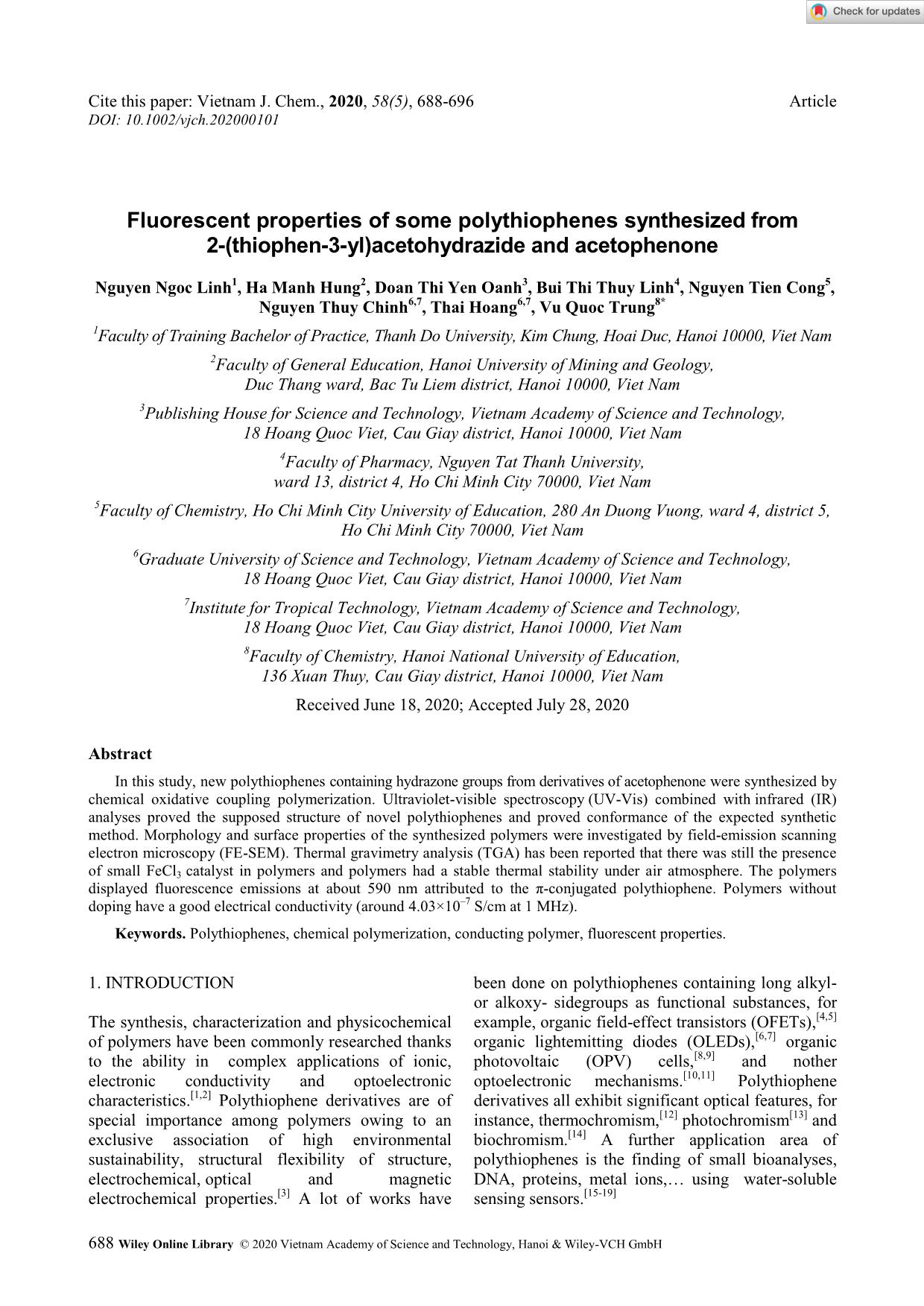
Trang 1
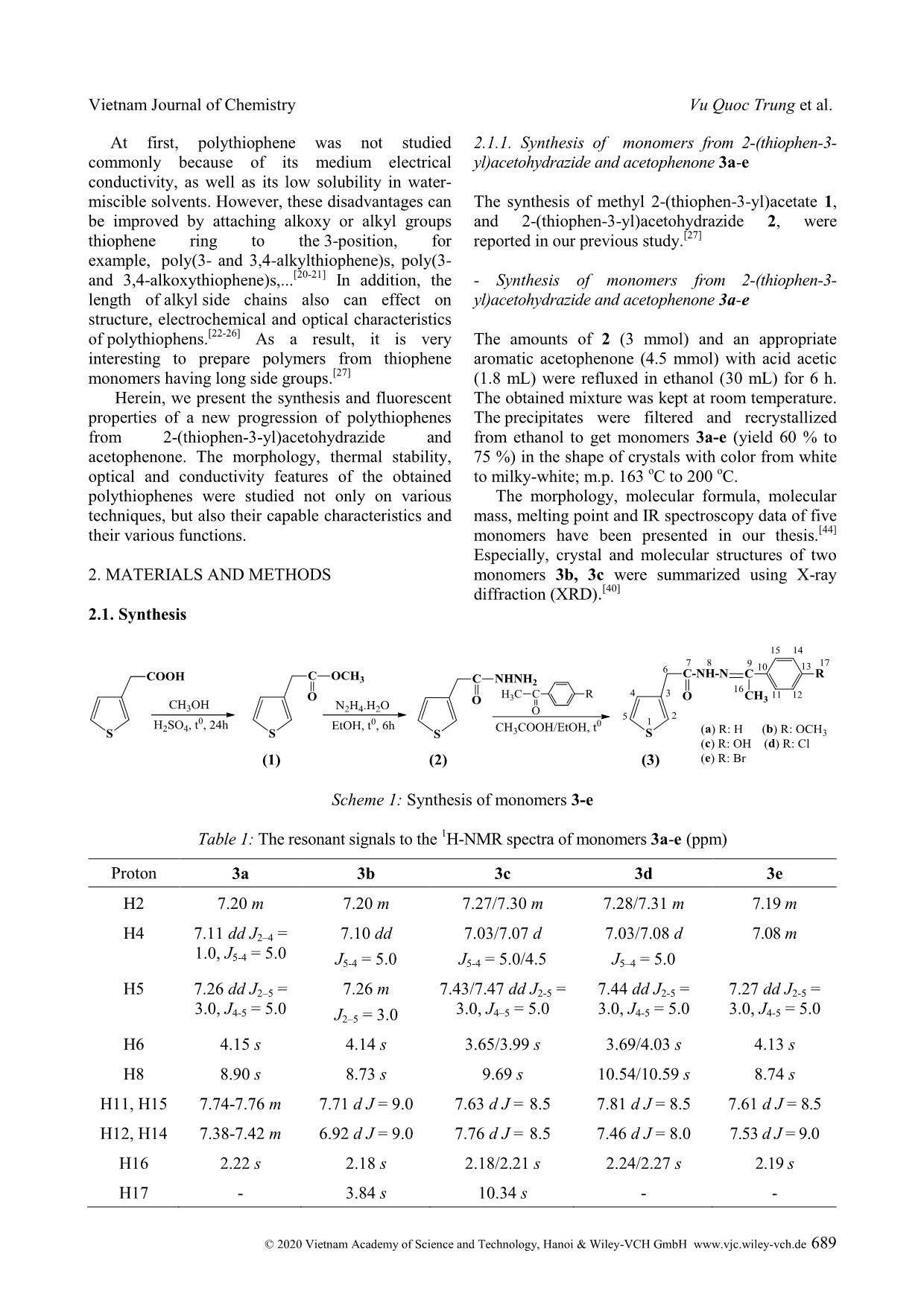
Trang 2
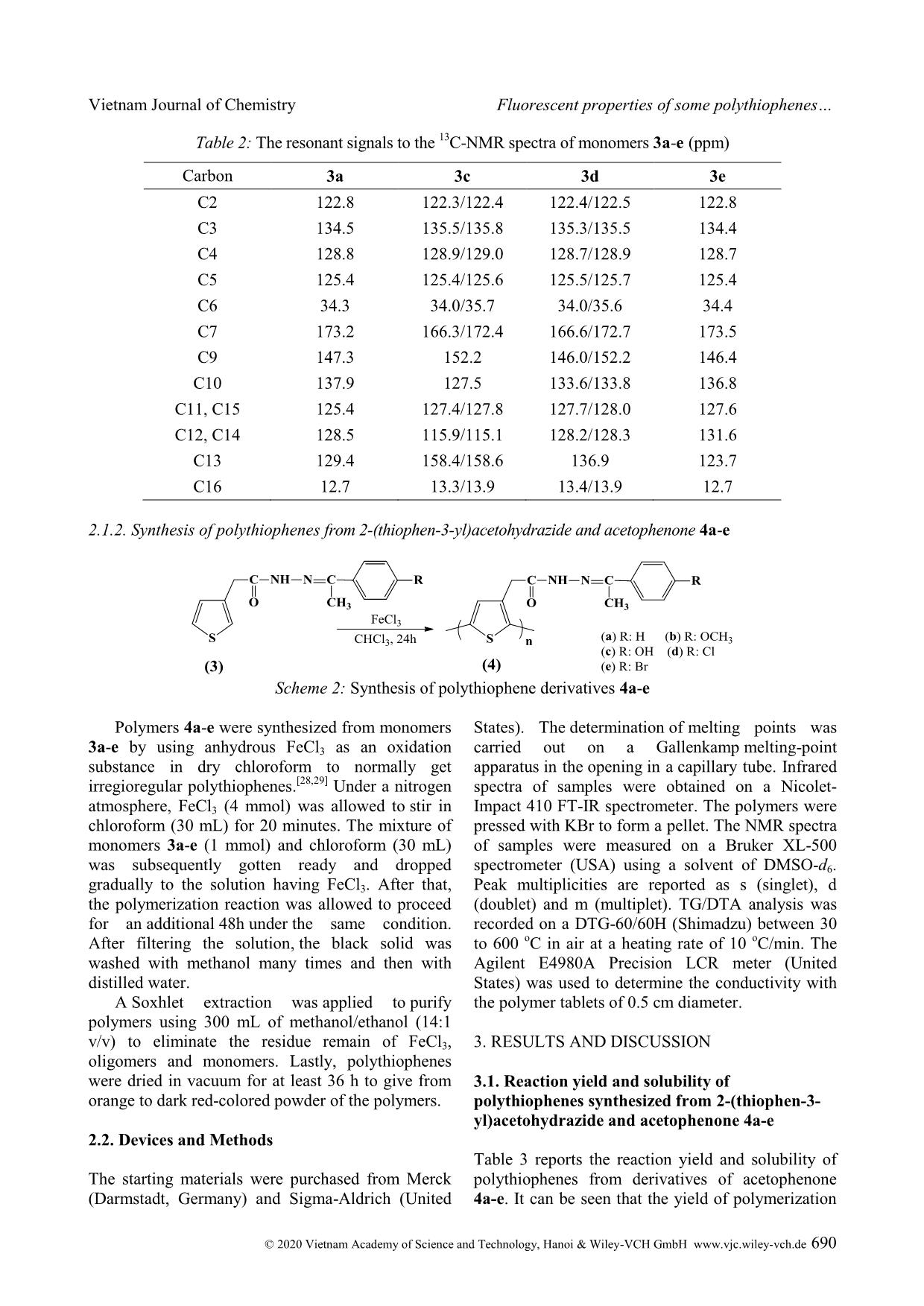
Trang 3
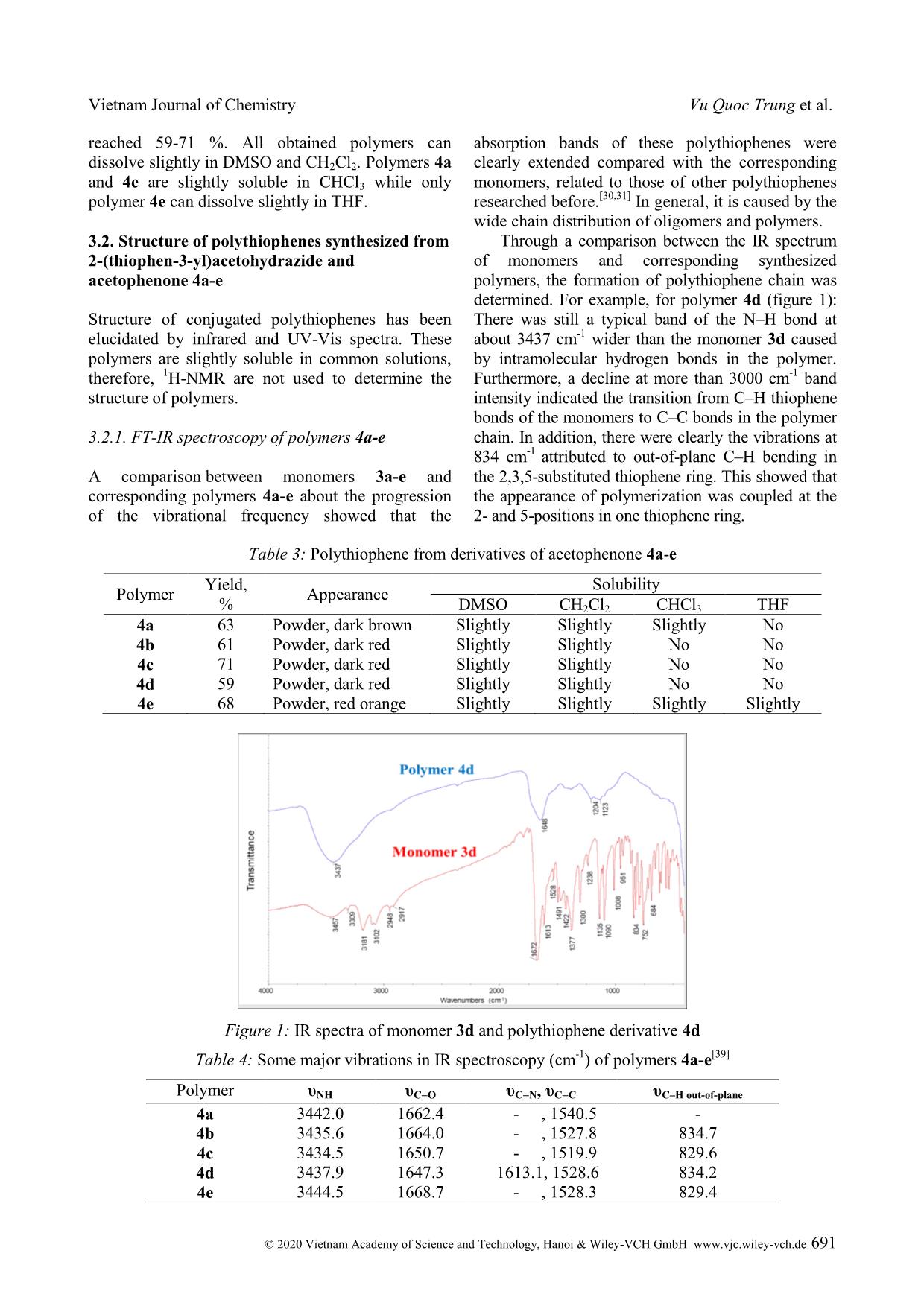
Trang 4
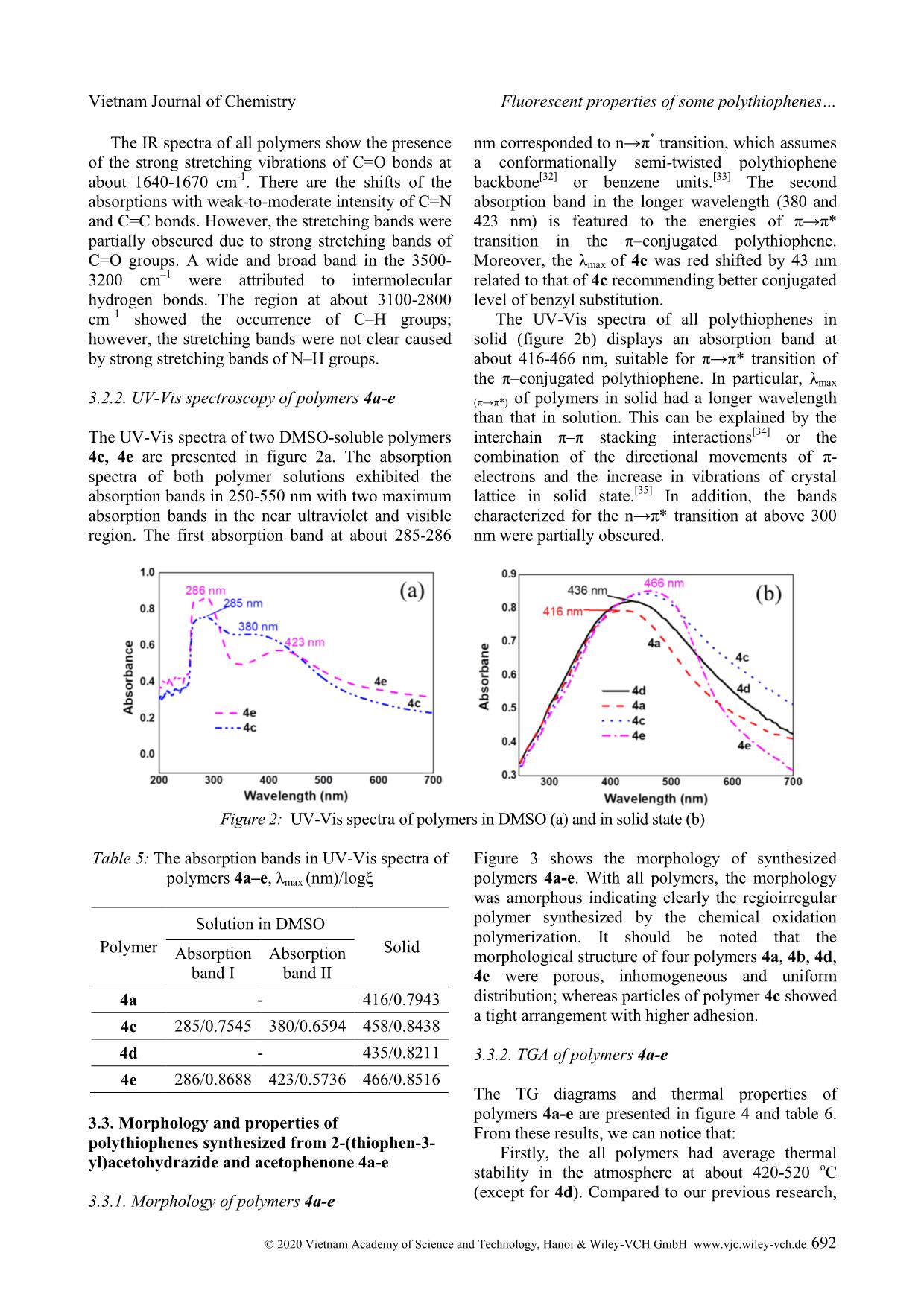
Trang 5
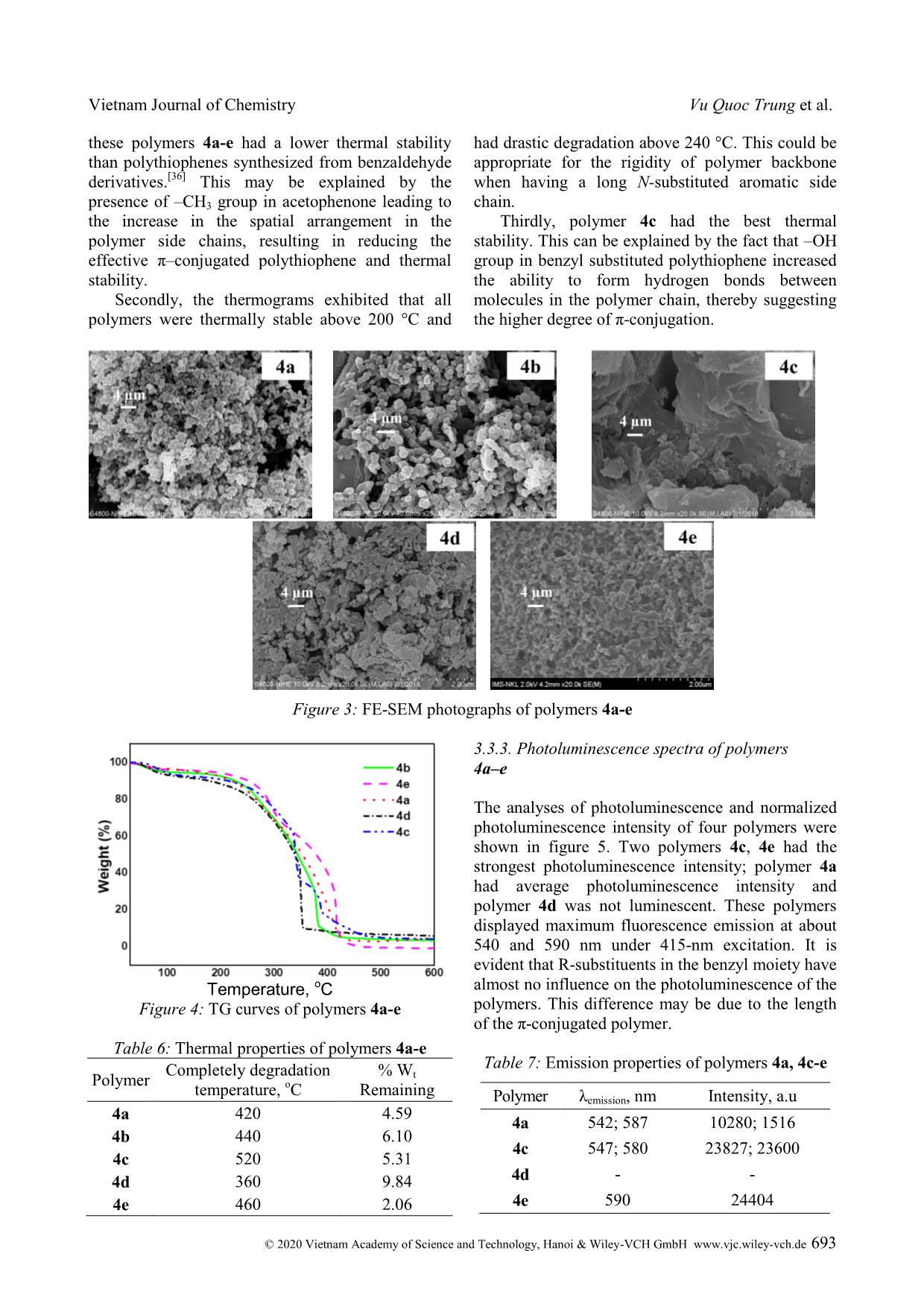
Trang 6
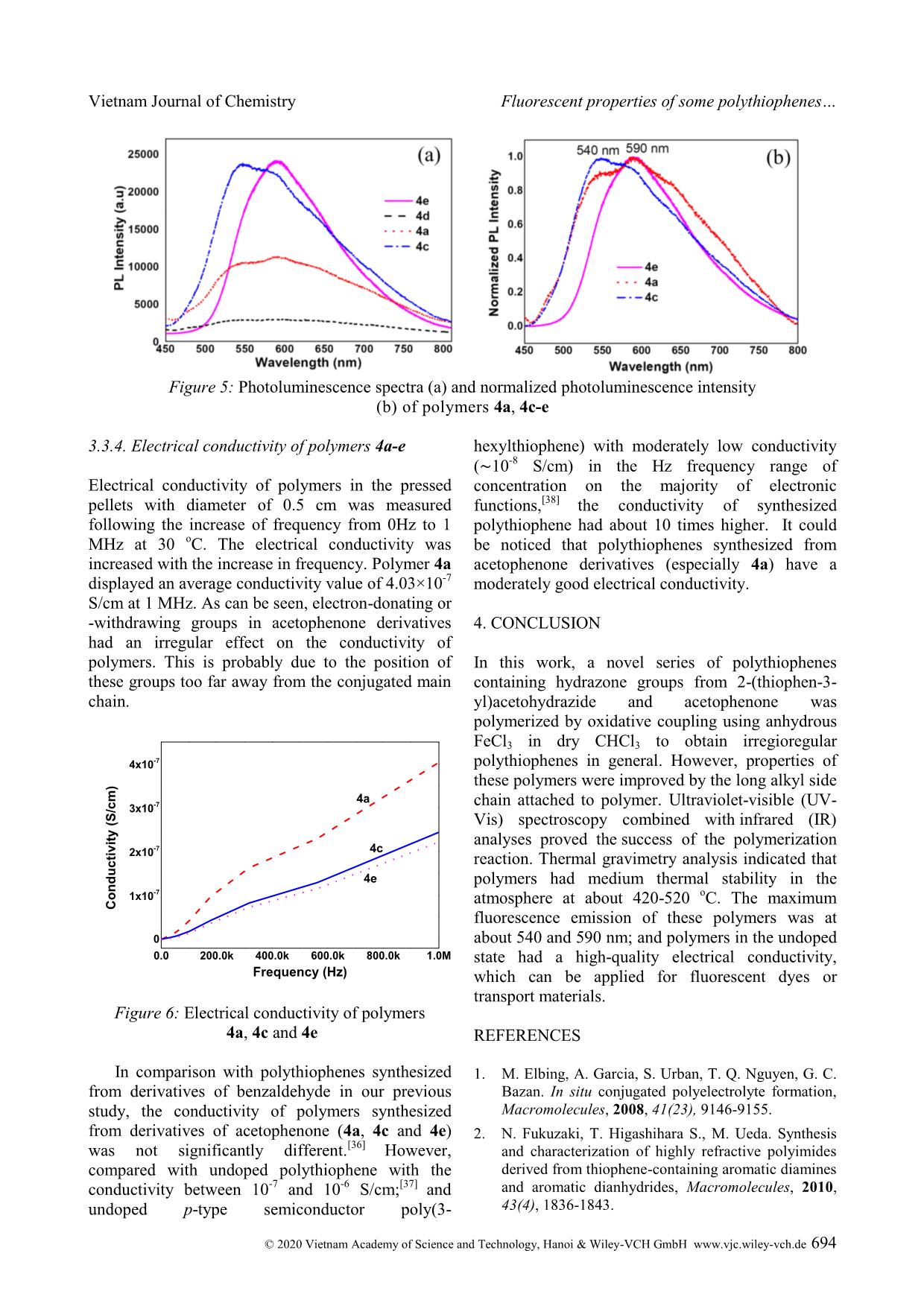
Trang 7
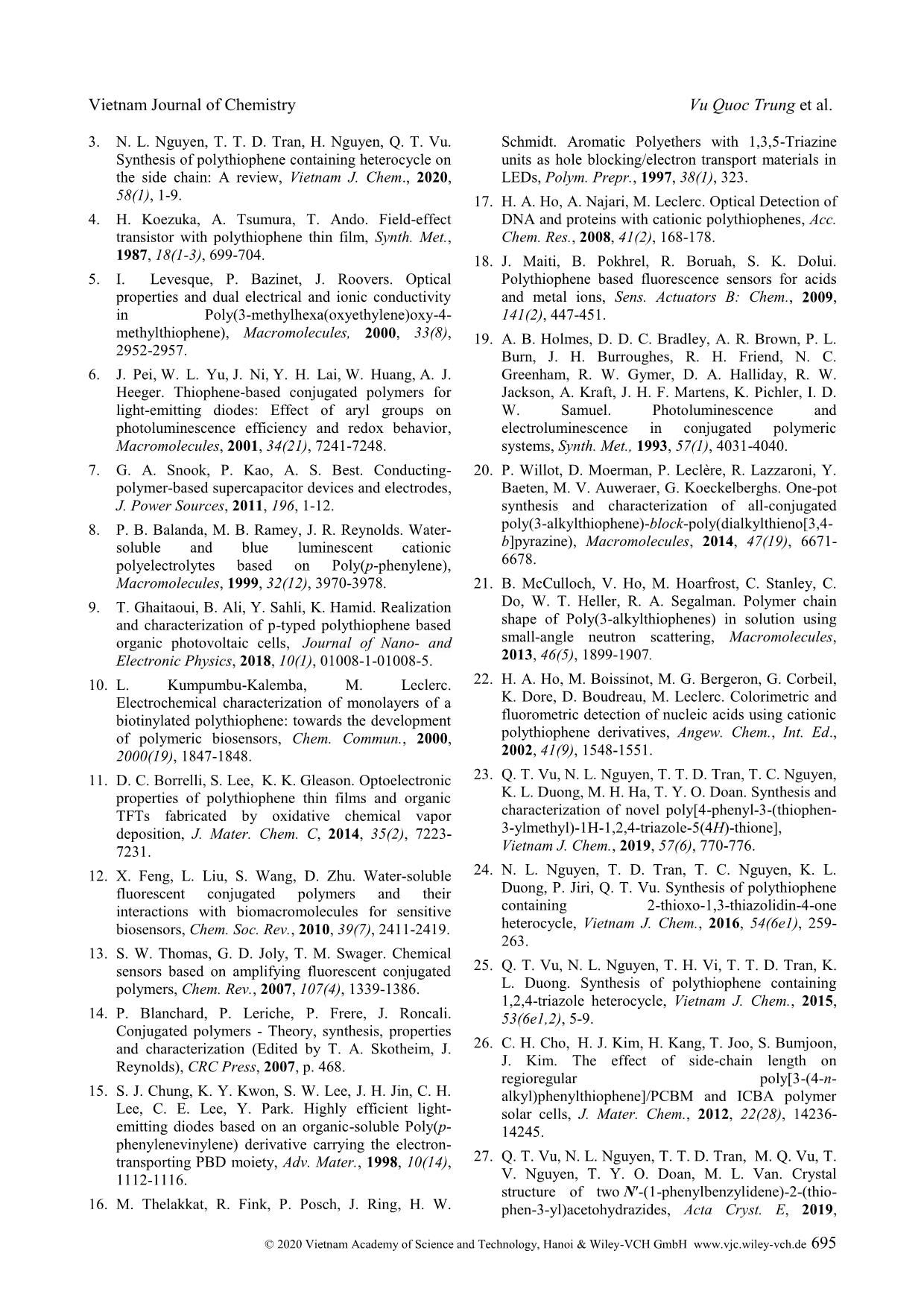
Trang 8
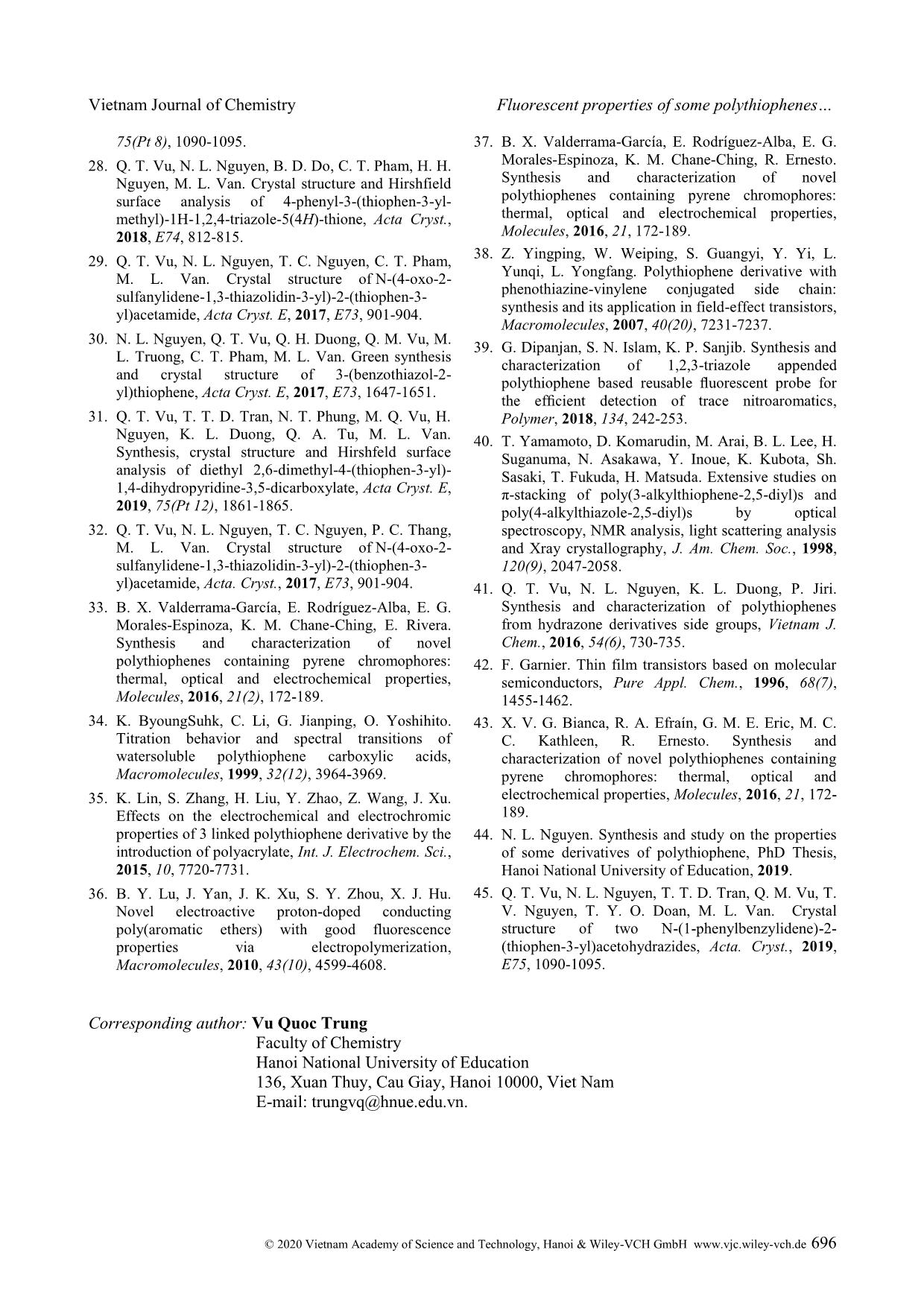
Trang 9
Tóm tắt nội dung tài liệu: Fluorescent properties of some polythiophenes synthesized from 2-(thiophen-3-yl)acetohydrazide and acetophenone
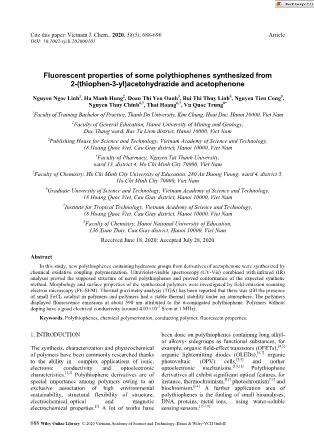
Cite this paper: Vietnam J. Chem., 2020, 58(5), 688-696 Article DOI: 10.1002/vjch.202000101 688 Wiley Online Library © 2020 Vietnam Academy of Science and Technology, Hanoi & Wiley-VCH GmbH Fluorescent properties of some polythiophenes synthesized from 2-(thiophen-3-yl)acetohydrazide and acetophenone Nguyen Ngoc Linh1, Ha Manh Hung2, Doan Thi Yen Oanh3, Bui Thi Thuy Linh4, Nguyen Tien Cong5, Nguyen Thuy Chinh 6,7 , Thai Hoang 6,7 , Vu Quoc Trung 8* 1 Faculty of Training Bachelor of Practice, Thanh Do University, Kim Chung, Hoai Duc, Hanoi 10000, Viet Nam 2 Faculty of General Education, Hanoi University of Mining and Geology, Duc Thang ward, Bac Tu Liem district, Hanoi 10000, Viet Nam 3 Publishing House for Science and Technology, Vietnam Academy of Science and Technology, 18 Hoang Quoc Viet, Cau Giay district, Hanoi 10000, Viet Nam 4 Faculty of Pharmacy, Nguyen Tat Thanh University, ward 13, district 4, Ho Chi Minh City 70000, Viet Nam 5 Faculty of Chemistry, Ho Chi Minh City University of Education, 280 An Duong Vuong, ward 4, district 5, Ho Chi Minh City 70000, Viet Nam 6 Graduate University of Science and Technology, Vietnam Academy of Science and Technology, 18 Hoang Quoc Viet, Cau Giay district, Hanoi 10000, Viet Nam 7 Institute for Tropical Technology, Vietnam Academy of Science and Technology, 18 Hoang Quoc Viet, Cau Giay district, Hanoi 10000, Viet Nam 8 Faculty of Chemistry, Hanoi National University of Education, 136 Xuan Thuy, Cau Giay district, Hanoi 10000, Viet Nam Received June 18, 2020; Accepted July 28, 2020 Abstract In this study, new polythiophenes containing hydrazone groups from derivatives of acetophenone were synthesized by chemical oxidative coupling polymerization. Ultraviolet-visible spectroscopy (UV-Vis) combined with infrared (IR) analyses proved the supposed structure of novel polythiophenes and proved conformance of the expected synthetic method. Morphology and surface properties of the synthesized polymers were investigated by field-emission scanning electron microscopy (FE-SEM). Thermal gravimetry analysis (TGA) has been reported that there was still the presence of small FeCl3 catalyst in polymers and polymers had a stable thermal stability under air atmosphere. The polymers displayed fluorescence emissions at about 590 nm attributed to the π-conjugated polythiophene. Polymers without doping have a good electrical conductivity (around 4.03×10 –7 S/cm at 1 MHz). Keywords. Polythiophenes, chemical polymerization, conducting polymer, fluorescent properties. 1. INTRODUCTION The synthesis, characterization and physicochemical of polymers have been commonly researched thanks to the ability in complex applications of ionic, electronic conductivity and optoelectronic characteristics. [1,2] Polythiophene derivatives are of special importance among polymers owing to an exclusive association of high environmental sustainability, structural flexibility of structure, electrochemical, optical and magnetic electrochemical properties. [3] A lot of works have been done on polythiophenes containing long alkyl- or alkoxy- sidegroups as functional substances, for example, organic field-effect transistors (OFETs), [4,5] organic lightemitting diodes (OLEDs), [6,7] organic photovoltaic (OPV) cells, [8,9] and nother optoelectronic mechanisms. [10,11] Polythiophene derivatives all exhibit significant optical features, for instance, thermochromism, [12] photochromism [13] and biochromism. [14] A further application area of polythiophenes is the finding of small bioanalyses, DNA, proteins, metal ions, using water-soluble sensing sensors. [15-19] Vietnam Journal of Chemistry Vu Quoc Trung et al. © 2020 Vietnam Academy of Science and Technology, Hanoi & Wiley-VCH GmbH www.vjc.wiley-vch.de 689 At first, polythiophene was not studied commonly because of its medium electrical conductivity, as well as its low solubility in water- miscible solvents. However, these disadvantages can be improved by attaching alkoxy or alkyl groups thiophene ring to the 3-position, for example, poly(3- and 3,4-alkylthiophene)s, poly(3- and 3,4-alkoxythiophene)s,... [20-21] In addition, the length of alkyl side chains also can effect on structure, electrochemical and optical characteristics of polythiophens. [22-26] As a result, it is very interesting to prepare polymers from thiophene monomers having long side groups. [27] Herein, we present the synthesis and fluorescent properties of a new progression of polythiophenes from 2-(thiophen-3-yl)acetohydrazide and acetophenone. The morphology, thermal stability, optical and conductivity features of the obtained polythiophenes were studied not only on various techniques, but also their capable characteristics and their various functions. 2. MATERIALS AND METHODS 2.1. Synthesis 2.1.1. Synthesis of monomers from 2-(thiophen-3- yl)acetohydrazide and acetophenone 3a-e The synthesis of methyl 2-(thiophen-3-yl)acetate 1, and 2-(thiophen-3-yl)acetohydrazide 2, were reported in our previous study. [27] - Synthesis of monomers from 2-(thiophen-3- yl)acetohydrazide and acetophenone 3a-e The amounts of 2 (3 mmol) and an appropriate aromatic acetophenone (4.5 mmol) with acid acetic (1.8 mL) were refluxed in ethanol (30 mL) for 6 h. The obtained mixture was kept at room temperature. The precipitates were filtered and recrystallized from ethanol to get monomers 3a-e (yield 60 % to 75 %) in the shape of crystals with color from white to milky-white; m.p. 163 o C to 200 o C. The morphology, molecular formula, molecular mass, melting point and IR spectroscopy data of five monomers have been presented in our thesis. [44] Especially, crystal and molecular structures of two monomers 3b, 3c were summarized using X-ray diffraction (XRD) ... nce and normalized photoluminescence intensity of four polymers were shown in figure 5. Two polymers 4c, 4e had the strongest photoluminescence intensity; polymer 4a had average photoluminescence intensity and polymer 4d was not luminescent. These polymers displayed maximum fluorescence emission at about 540 and 590 nm under 415-nm excitation. It is evident that R-substituents in the benzyl moiety have almost no influence on the photoluminescence of the polymers. This difference may be due to the length of the π-conjugated polymer. Table 7: Emission properties of polymers 4a, 4c-e Polymer λemission, nm Intensity, a.u 4a 542; 587 10280; 1516 4c 547; 580 23827; 23600 4d - - 4e 590 24404 Vietnam Journal of Chemistry Fluorescent properties of some polythiophenes © 2020 Vietnam Academy of Science and Technology, Hanoi & Wiley-VCH GmbH www.vjc.wiley-vch.de 694 Figure 5: Photoluminescence spectra (a) and normalized photoluminescence intensity (b) of polymers 4a, 4c-e 3.3.4. Electrical conductivity of polymers 4a-e Electrical conductivity of polymers in the pressed pellets with diameter of 0.5 cm was measured following the increase of frequency from 0Hz to 1 MHz at 30 o C. The electrical conductivity was increased with the increase in frequency. Polymer 4a displayed an average conductivity value of 4.03×10 -7 S/cm at 1 MHz. As can be seen, electron-donating or -withdrawing groups in acetophenone derivatives had an irregular effect on the conductivity of polymers. This is probably due to the position of these groups too far away from the conjugated main chain. 0.0 200.0k 400.0k 600.0k 800.0k 1.0M 0 1x10 -7 2x10 -7 3x10 -7 4x10 -7 4e 4c 4a C o n d u c ti v it y ( S /c m ) Frequency (Hz) Figure 6: Electrical conductivity of polymers 4a, 4c and 4e In comparison with polythiophenes synthesized from derivatives of benzaldehyde in our previous study, the conductivity of polymers synthesized from derivatives of acetophenone (4a, 4c and 4e) was not significantly different. [36] However, compared with undoped polythiophene with the conductivity between 10 -7 and 10 -6 S/cm; [37] and undoped p-type semiconductor poly(3- hexylthiophene) with moderately low conductivity (∼10-8 S/cm) in the Hz frequency range of concentration on the majority of electronic functions, [38] the conductivity of synthesized polythiophene had about 10 times higher. It could be noticed that polythiophenes synthesized from acetophenone derivatives (especially 4a) have a moderately good electrical conductivity. 4. CONCLUSION In this work, a novel series of polythiophenes containing hydrazone groups from 2-(thiophen-3- yl)acetohydrazide and acetophenone was polymerized by oxidative coupling using anhydrous FeCl3 in dry CHCl3 to obtain irregioregular polythiophenes in general. However, properties of these polymers were improved by the long alkyl side chain attached to polymer. Ultraviolet-visible (UV- Vis) spectroscopy combined with infrared (IR) analyses proved the success of the polymerization reaction. Thermal gravimetry analysis indicated that polymers had medium thermal stability in the atmosphere at about 420-520 o C. The maximum fluorescence emission of these polymers was at about 540 and 590 nm; and polymers in the undoped state had a high-quality electrical conductivity, which can be applied for fluorescent dyes or transport materials. REFERENCES 1. M. Elbing, A. Garcia, S. Urban, T. Q. Nguyen, G. C. Bazan. In situ conjugated polyelectrolyte formation, Macromolecules, 2008, 41(23), 9146-9155. 2. N. Fukuzaki, T. Higashihara S., M. Ueda. Synthesis and characterization of highly refractive polyimides derived from thiophene-containing aromatic diamines and aromatic dianhydrides, Macromolecules, 2010, 43(4), 1836-1843. Vietnam Journal of Chemistry Vu Quoc Trung et al. © 2020 Vietnam Academy of Science and Technology, Hanoi & Wiley-VCH GmbH www.vjc.wiley-vch.de 695 3. N. L. Nguyen, T. T. D. Tran, H. Nguyen, Q. T. Vu. Synthesis of polythiophene containing heterocycle on the side chain: A review, Vietnam J. Chem., 2020, 58(1), 1-9. 4. H. Koezuka, A. Tsumura, T. Ando. Field-effect transistor with polythiophene thin film, Synth. Met., 1987, 18(1-3), 699-704. 5. I. Levesque, P. Bazinet, J. Roovers. Optical properties and dual electrical and ionic conductivity in Poly(3-methylhexa(oxyethylene)oxy-4- methylthiophene), Macromolecules, 2000, 33(8), 2952-2957. 6. J. Pei, W. L. Yu, J. Ni, Y. H. Lai, W. Huang, A. J. Heeger. Thiophene-based conjugated polymers for light-emitting diodes: Effect of aryl groups on photoluminescence efficiency and redox behavior, Macromolecules, 2001, 34(21), 7241-7248. 7. G. A. Snook, P. Kao, A. S. Best. Conducting- polymer-based supercapacitor devices and electrodes, J. Power Sources, 2011, 196, 1-12. 8. P. B. Balanda, M. B. Ramey, J. R. Reynolds. Water- soluble and blue luminescent cationic polyelectrolytes based on Poly(p-phenylene), Macromolecules, 1999, 32(12), 3970-3978. 9. T. Ghaitaoui, B. Ali, Y. Sahli, K. Hamid. Realization and characterization of p-typed polythiophene based organic photovoltaic cells, Journal of Nano- and Electronic Physics, 2018, 10(1), 01008-1-01008-5. 10. L. Kumpumbu-Kalemba, M. Leclerc. Electrochemical characterization of monolayers of a biotinylated polythiophene: towards the development of polymeric biosensors, Chem. Commun., 2000, 2000(19), 1847-1848. 11. D. C. Borrelli, S. Lee, K. K. Gleason. Optoelectronic properties of polythiophene thin films and organic TFTs fabricated by oxidative chemical vapor deposition, J. Mater. Chem. C, 2014, 35(2), 7223- 7231. 12. X. Feng, L. Liu, S. Wang, D. Zhu. Water-soluble fluorescent conjugated polymers and their interactions with biomacromolecules for sensitive biosensors, Chem. Soc. Rev., 2010, 39(7), 2411-2419. 13. S. W. Thomas, G. D. Joly, T. M. Swager. Chemical sensors based on amplifying fluorescent conjugated polymers, Chem. Rev., 2007, 107(4), 1339-1386. 14. P. Blanchard, P. Leriche, P. Frere, J. Roncali. Conjugated polymers - Theory, synthesis, properties and characterization (Edited by T. A. Skotheim, J. Reynolds), CRC Press, 2007, p. 468. 15. S. J. Chung, K. Y. Kwon, S. W. Lee, J. H. Jin, C. H. Lee, C. E. Lee, Y. Park. Highly efficient light- emitting diodes based on an organic-soluble Poly(p- phenylenevinylene) derivative carrying the electron- transporting PBD moiety, Adv. Mater., 1998, 10(14), 1112-1116. 16. M. Thelakkat, R. Fink, P. Posch, J. Ring, H. W. Schmidt. Aromatic Polyethers with 1,3,5-Triazine units as hole blocking/electron transport materials in LEDs, Polym. Prepr., 1997, 38(1), 323. 17. H. A. Ho, A. Najari, M. Leclerc. Optical Detection of DNA and proteins with cationic polythiophenes, Acc. Chem. Res., 2008, 41(2), 168-178. 18. J. Maiti, B. Pokhrel, R. Boruah, S. K. Dolui. Polythiophene based fluorescence sensors for acids and metal ions, Sens. Actuators B: Chem., 2009, 141(2), 447-451. 19. A. B. Holmes, D. D. C. Bradley, A. R. Brown, P. L. Burn, J. H. Burroughes, R. H. Friend, N. C. Greenham, R. W. Gymer, D. A. Halliday, R. W. Jackson, A. Kraft, J. H. F. Martens, K. Pichler, I. D. W. Samuel. Photoluminescence and electroluminescence in conjugated polymeric systems, Synth. Met., 1993, 57(1), 4031-4040. 20. P. Willot, D. Moerman, P. Leclère, R. Lazzaroni, Y. Baeten, M. V. Auweraer, G. Koeckelberghs. One-pot synthesis and characterization of all-conjugated poly(3-alkylthiophene)-block-poly(dialkylthieno[3,4- b]pyrazine), Macromolecules, 2014, 47(19), 6671- 6678. 21. B. McCulloch, V. Ho, M. Hoarfrost, C. Stanley, C. Do, W. T. Heller, R. A. Segalman. Polymer chain shape of Poly(3-alkylthiophenes) in solution using small-angle neutron scattering, Macromolecules, 2013, 46(5), 1899-1907. 22. H. A. Ho, M. Boissinot, M. G. Bergeron, G. Corbeil, K. Dore, D. Boudreau, M. Leclerc. Colorimetric and fluorometric detection of nucleic acids using cationic polythiophene derivatives, Angew. Chem., Int. Ed., 2002, 41(9), 1548-1551. 23. Q. T. Vu, N. L. Nguyen, T. T. D. Tran, T. C. Nguyen, K. L. Duong, M. H. Ha, T. Y. O. Doan. Synthesis and characterization of novel poly[4-phenyl-3-(thiophen- 3-ylmethyl)-1H-1,2,4-triazole-5(4H)-thione], Vietnam J. Chem., 2019, 57(6), 770-776. 24. N. L. Nguyen, T. D. Tran, T. C. Nguyen, K. L. Duong, P. Jiri, Q. T. Vu. Synthesis of polythiophene containing 2-thioxo-1,3-thiazolidin-4-one heterocycle, Vietnam J. Chem., 2016, 54(6e1), 259- 263. 25. Q. T. Vu, N. L. Nguyen, T. H. Vi, T. T. D. Tran, K. L. Duong. Synthesis of polythiophene containing 1,2,4-triazole heterocycle, Vietnam J. Chem., 2015, 53(6e1,2), 5-9. 26. C. H. Cho, H. J. Kim, H. Kang, T. Joo, S. Bumjoon, J. Kim. The effect of side-chain length on regioregular poly[3-(4-n- alkyl)phenylthiophene]/PCBM and ICBA polymer solar cells, J. Mater. Chem., 2012, 22(28), 14236- 14245. 27. Q. T. Vu, N. L. Nguyen, T. T. D. Tran, M. Q. Vu, T. V. Nguyen, T. Y. O. Doan, M. L. Van. Crystal structure of two N′-(1-phenylbenzylidene)-2-(thio- phen-3-yl)acetohydrazides, Acta Cryst. E, 2019, Vietnam Journal of Chemistry Fluorescent properties of some polythiophenes © 2020 Vietnam Academy of Science and Technology, Hanoi & Wiley-VCH GmbH www.vjc.wiley-vch.de 696 75(Pt 8), 1090-1095. 28. Q. T. Vu, N. L. Nguyen, B. D. Do, C. T. Pham, H. H. Nguyen, M. L. Van. Crystal structure and Hirshfield surface analysis of 4-phenyl-3-(thiophen-3-yl- methyl)-1H-1,2,4-triazole-5(4H)-thione, Acta Cryst., 2018, E74, 812-815. 29. Q. T. Vu, N. L. Nguyen, T. C. Nguyen, C. T. Pham, M. L. Van. Crystal structure of N-(4-oxo-2- sulfanylidene-1,3-thiazolidin-3-yl)-2-(thiophen-3- yl)acetamide, Acta Cryst. E, 2017, E73, 901-904. 30. N. L. Nguyen, Q. T. Vu, Q. H. Duong, Q. M. Vu, M. L. Truong, C. T. Pham, M. L. Van. Green synthesis and crystal structure of 3-(benzothiazol-2- yl)thiophene, Acta Cryst. E, 2017, E73, 1647-1651. 31. Q. T. Vu, T. T. D. Tran, N. T. Phung, M. Q. Vu, H. Nguyen, K. L. Duong, Q. A. Tu, M. L. Van. Synthesis, crystal structure and Hirshfeld surface analysis of diethyl 2,6-dimethyl-4-(thiophen-3-yl)- 1,4-dihydropyridine-3,5-dicarboxylate, Acta Cryst. E, 2019, 75(Pt 12), 1861-1865. 32. Q. T. Vu, N. L. Nguyen, T. C. Nguyen, P. C. Thang, M. L. Van. Crystal structure of N-(4-oxo-2- sulfanylidene-1,3-thiazolidin-3-yl)-2-(thiophen-3- yl)acetamide, Acta. Cryst., 2017, E73, 901-904. 33. B. X. Valderrama-García, E. Rodríguez-Alba, E. G. Morales-Espinoza, K. M. Chane-Ching, E. Rivera. Synthesis and characterization of novel polythiophenes containing pyrene chromophores: thermal, optical and electrochemical properties, Molecules, 2016, 21(2), 172-189. 34. K. ByoungSuhk, C. Li, G. Jianping, O. Yoshihito. Titration behavior and spectral transitions of watersoluble polythiophene carboxylic acids, Macromolecules, 1999, 32(12), 3964-3969. 35. K. Lin, S. Zhang, H. Liu, Y. Zhao, Z. Wang, J. Xu. Effects on the electrochemical and electrochromic properties of 3 linked polythiophene derivative by the introduction of polyacrylate, Int. J. Electrochem. Sci., 2015, 10, 7720-7731. 36. B. Y. Lu, J. Yan, J. K. Xu, S. Y. Zhou, X. J. Hu. Novel electroactive proton-doped conducting poly(aromatic ethers) with good fluorescence properties via electropolymerization, Macromolecules, 2010, 43(10), 4599-4608. 37. B. X. Valderrama-García, E. Rodríguez-Alba, E. G. Morales-Espinoza, K. M. Chane-Ching, R. Ernesto. Synthesis and characterization of novel polythiophenes containing pyrene chromophores: thermal, optical and electrochemical properties, Molecules, 2016, 21, 172-189. 38. Z. Yingping, W. Weiping, S. Guangyi, Y. Yi, L. Yunqi, L. Yongfang. Polythiophene derivative with phenothiazine-vinylene conjugated side chain: synthesis and its application in field-effect transistors, Macromolecules, 2007, 40(20), 7231-7237. 39. G. Dipanjan, S. N. Islam, K. P. Sanjib. Synthesis and characterization of 1,2,3-triazole appended polythiophene based reusable fluorescent probe for the efficient detection of trace nitroaromatics, Polymer, 2018, 134, 242-253. 40. T. Yamamoto, D. Komarudin, M. Arai, B. L. Lee, H. Suganuma, N. Asakawa, Y. Inoue, K. Kubota, Sh. Sasaki, T. Fukuda, H. Matsuda. Extensive studies on π-stacking of poly(3-alkylthiophene-2,5-diyl)s and poly(4-alkylthiazole-2,5-diyl)s by optical spectroscopy, NMR analysis, light scattering analysis and Xray crystallography, J. Am. Chem. Soc., 1998, 120(9), 2047-2058. 41. Q. T. Vu, N. L. Nguyen, K. L. Duong, P. Jiri. Synthesis and characterization of polythiophenes from hydrazone derivatives side groups, Vietnam J. Chem., 2016, 54(6), 730-735. 42. F. Garnier. Thin film transistors based on molecular semiconductors, Pure Appl. Chem., 1996, 68(7), 1455-1462. 43. X. V. G. Bianca, R. A. Efraín, G. M. E. Eric, M. C. C. Kathleen, R. Ernesto. Synthesis and characterization of novel polythiophenes containing pyrene chromophores: thermal, optical and electrochemical properties, Molecules, 2016, 21, 172- 189. 44. N. L. Nguyen. Synthesis and study on the properties of some derivatives of polythiophene, PhD Thesis, Hanoi National University of Education, 2019. 45. Q. T. Vu, N. L. Nguyen, T. T. D. Tran, Q. M. Vu, T. V. Nguyen, T. Y. O. Doan, M. L. Van. Crystal structure of two N-(1-phenylbenzylidene)-2- (thiophen-3-yl)acetohydrazides, Acta. Cryst., 2019, E75, 1090-1095. Corresponding author: Vu Quoc Trung Faculty of Chemistry Hanoi National University of Education 136, Xuan Thuy, Cau Giay, Hanoi 10000, Viet Nam E-mail: trungvq@hnue.edu.vn.
File đính kèm:
 fluorescent_properties_of_some_polythiophenes_synthesized_fr.pdf
fluorescent_properties_of_some_polythiophenes_synthesized_fr.pdf

